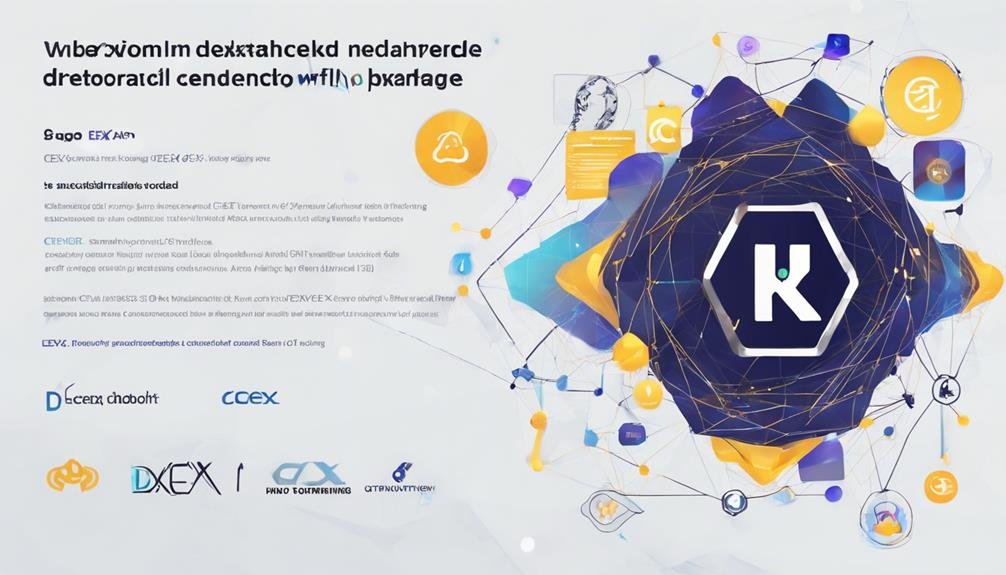When comparing Centralized Exchanges (CEX) and Decentralized Exchanges (DEX), you encounter profound differences in control, ownership, privacy, liquidity, regulatory compliance, risk tolerance, and security measures. CEX platforms prioritize user-friendly interfaces and high liquidity. In contrast, DEX platforms offer heightened security, user autonomy, and lower transaction fees through smart contracts.
DEXs, like Uniswap and Sushiswap, excel in providing autonomy, transparency, and community-driven trading experiences. Understanding these nuances is pivotal in effectively exploring the cryptocurrency trading landscape, highlighting significant distinctions that shape traders’ experiences.
Brief Overview of 10 Best Insights: CEX Vs DEX Differences
- DEX platforms offer security through smart contracts.
- CEX platforms prioritize user-friendly interfaces and high liquidity.
- DEXs promote lower fees and user autonomy.
- CEXs may have higher liquidity but expose users to counterparty risks.
- DEX platforms provide privacy and data ownership advantages.
Centralized Exchange (CEX) Overview
Centralized exchanges, commonly known as CEXs, serve as intermediaries facilitating cryptocurrency trading by requiring users to entrust their assets for transactions. These platforms offer user-friendly interfaces, making it easy for individuals to buy, sell, and trade various cryptocurrencies. One key advantage of CEXs is their high liquidity, ensuring traders can quickly execute their orders without significant price slippage.
Moreover, CEXs adhere to regulatory standards, providing users with security and trust while operating within the cryptocurrency market. By managing users’ funds centrally, these exchanges offer added convenience and accessibility to individuals looking to engage in digital asset trading. Examples of well-known CEXs include Binance, Coinbase, and Kraken, each offering a range of features tailored to meet the needs of cryptocurrency investors. Overall, centralized exchanges play an essential role in the crypto ecosystem, providing a bridge for users to access various digital assets relatively easily.
Decentralized Exchange (DEX) Overview

Decentralized exchanges (DEXs) offer distinct advantages over centralized counterparts, such as increased security and user control over funds. Unique features like smart contracts and automated market makers enable direct peer-to-peer trading without intermediaries. Observing market trends in the DEX space provides valuable insights into the evolving landscape of decentralized finance.
DEX Advantages Explained
In cryptocurrency trading, DEXs offer users security and autonomy that traditional centralized exchanges cannot match. Decentralized exchanges operate on transparent networks, where users control their funds through smart contracts, promoting security and reducing reliance on centralized entities. By facilitating peer-to-peer trades without a central authority, DEXs enhance user autonomy, emphasizing a community-driven approach to trading.
Additionally, DEXs like Uniswap charge lower transaction fees, such as the 0.05% fee observed in late 2021, making them more cost-effective than major centralized exchanges. These factors combined make DEXs an attractive option for those seeking secure, transparent, and user-controlled trading experiences in the cryptocurrency space.
Unique DEX Features
Moving from the advantages of DEXs, let’s explore the unique features that set Decentralized Exchanges apart in cryptocurrency trading.
- Smart Contracts: DEXs operate through smart contracts, enabling secure and direct peer-to-peer trading without intermediaries.
- User Control: Users have full control over their funds on DEX platforms, ensuring autonomy and security through direct interactions facilitated by smart contracts.
- Liquidity Pools: DEXs rely on liquidity pools provided by users, allowing automated market makers to determine asset prices based on these ratios. This setup promotes efficient and transparent trading, benefiting liquidity providers and platform traders.
DEX Market Trends
Experiencing a surge in market activity, DEXs like Uniswap, Sushiswap, and PancakeSwap are reshaping the cryptocurrency trading landscape. DEX market volume exceeded $100 billion in August 2021, underlining the significant growth in decentralized exchange trading. Uniswap, a leading DEX, achieved a remarkable $10 billion trading volume in a single day, showcasing its popularity and liquidity.
Platforms like Sushiswap and PancakeSwap have attracted users with unique features, contributing to their growing traction. Lower fees, faster transactions, and user control over assets have fueled DEX adoption, driving the shift toward decentralized trading. As decentralized exchanges gain market share, more users are embracing the benefits they offer over centralized counterparts.
Control and Ownership Variances

With DEX platforms, you directly control and own your funds, eliminating the reliance on centralized entities for asset management. Here are three key differences highlighting the control and ownership variances between CEX and DEX:
- Peer-to-Peer Transactions: DEX facilitates transactions directly between users, ensuring you have full ownership and control over your assets without the need to trust a central authority.
- Counterparty Risk: CEX users must trust the exchange operator with their assets, exposing them to counterparty risk and potential security vulnerabilities that can compromise their ownership rights.
- Decentralization vs. Centralization: DEX prioritizes decentralization and user autonomy, providing you with a higher level of control and ownership over your assets compared to CEX, where funds are held in centralized wallets, increasing the risk of loss in case of security breaches or hacks.
Privacy Distinctions

When comparing CEX and DEX exchanges, the privacy distinctions are stark. Unlike CEX exchanges, DEX platforms prioritize user anonymity by necessitating minimal personal information. This guarantees that users can trade without jeopardizing their privacy.
Data Custody Control
For users concerned about data custody control and privacy distinctions, the choice between CEX and DEX platforms becomes important due to their fundamental differences in handling personal information.
- DEX platforms prioritize user privacy by requiring minimal personal information for trading.
- CEX exchanges impose KYC and AML procedures, compromising user privacy and anonymity.
- DEX allows users to trade without creating accounts or submitting extensive personal information.
Identity Verification Methods
Opt for decentralized exchanges (DEXs) if safeguarding your identity and prioritizing privacy is paramount when engaging in cryptocurrency trading. Unlike centralized exchanges (CEXs) that require KYC and AML verification, DEXs offer more anonymity by enabling trading without extensive identity verification processes. CEXs collect user data for regulatory compliance, potentially compromising user privacy.
In contrast, DEXs prioritize user privacy by reducing the need to disclose personal information, enhancing security for traders. Privacy-conscious individuals often prefer DEXs due to their privacy-focused approach, allowing for a more secure trading environment without extensive identity verification requirements. When choosing between CEXs and DEXs, consider the privacy and anonymity you desire to ensure your personal information remains secure during cryptocurrency transactions.
Information Sharing Policies
Considering the privacy distinctions between CEXs and DEXs, it becomes evident that users’ personal information is handled differently on these cryptocurrency trading platforms.
- DEX platforms prioritize user privacy by requiring minimal personal information for trading, enhancing anonymity.
- Users can trade on DEX without creating accounts or undergoing extensive KYC procedures, safeguarding privacy.
- In contrast, CEX exchanges impose KYC and AML requirements, compromising user anonymity by mandating personal information and identification documents for trading.
These distinctions highlight how DEX platforms prioritize user privacy and anonymity through reduced data collection and verification processes, offering a more discreet trading environment than CEX exchanges.
Liquidity Differences

CEXs outshine DEXs’ liquidity levels due to their robust user bases and substantial order books. This high liquidity on centralized exchanges enables better price discovery and reduces slippage, especially for significant trades. In contrast, DEXs heavily rely on user-provided liquidity, resulting in lower overall liquidity levels. This can lead to increased slippage and higher costs for larger transactions than CEXs.
While DEX liquidity gradually increases, it must catch up to centralized exchanges. The deep order books and extensive user bases on CEXs create an environment where traders can swiftly execute trades with minimal price impact. On the other hand, DEX users may encounter challenges with liquidity, especially when dealing with larger orders. Understanding these liquidity differences between CEXs and DEXs is essential for making informed decisions based on trading needs and preferences.
User Experience Contrasts

Prioritizing user-friendly interfaces and responsive customer support, centralized exchanges (CEXs) enhance the overall user experience for traders of all levels. CEXs offer intuitive platforms catering to beginners and experienced traders, providing easy navigation and quick access to trading tools.
The availability of mobile apps further enhances convenience, allowing users to manage their accounts on the go. CEXs also pride themselves on offering excellent customer support, ensuring that any issues or queries are promptly addressed for a seamless trading experience.
- User-Friendly Interfaces: CEXs focus on creating interfaces that are easy to navigate, reducing the learning curve for traders of all levels.
- Responsive Customer Support: Quick and efficient customer support services are a hallmark of CEXs, assisting whenever needed.
- Accessibility: With mobile apps and user-friendly interfaces, CEXs prioritize usability to guarantee a smooth trading experience for all users.
In contrast, due to their decentralized nature, DEXs may present a higher learning curve. Still, they continuously work towards enhancing user experience by improving accessibility and usability through innovative technologies like AMM protocols.
Regulatory Compliance Variances

Exploring the regulatory landscape reveals distinct compliance approaches between decentralized and centralized exchanges. Decentralized exchanges (DEXs) often operate autonomously, allowing them to circumvent certain regulatory hurdles and compliance requirements. On the other hand, centralized exchanges (CEXs) are more inclined to adhere to regulatory standards, prioritizing user protection and legal adherence.
Some exchanges, like ShapeShift, have shifted to a DEX model to avoid stringent Know Your Customer (KYC) and Anti-Money Laundering (AML) regulations. As regulatory scrutiny intensifies for centralized exchanges, it shapes the future regulatory landscape for all crypto exchanges. The choice between a CEX and a DEX can be greatly influenced by the regulatory environment and the compliance standards each type adheres to. Understanding the nuances of regulatory compliance, including KYC, AML regulations, compliance requirements, and legal adherence, is vital for users seeking to navigate the evolving terrain of regulatory scrutiny in the crypto space.
Risk Tolerance Considerations

Consider your risk tolerance carefully when deciding between centralized and decentralized exchanges, as it directly correlates with the custody models and level of control over your assets. Here are some key points to keep in mind:
- CEX Counterparty Risks: Centralized exchanges (CEX) require you to trust the platform with custody, exposing you to counterparty risks if the exchange fails or gets hacked.
- DEX Self-Custody Benefits: Decentralized exchanges (DEX) offer non-custodial services, allowing you more control over your assets. However, this also means you are responsible for safeguarding your assets, risking loss of access.
- Smart Contract Vulnerabilities: Understanding smart contract vulnerabilities is important when using DEX, as any flaws in the code can lead to potential risks of losing your assets. High-risk tolerance individuals might favor DEX for the self-custody advantages it provides, but being aware of the potential risks involved in managing your assets independently is crucial.
Liquidity Needs Evaluation

Consider methods like liquidity assessment, comparing market depth, and analyzing order books when evaluating your liquidity needs. These factors play an important role in determining the suitability of a platform for your trading requirements. Understanding the liquidity dynamics will help you make informed decisions when choosing between CEXs and DEXs.
Liquidity Assessment Methods
To evaluate liquidity needs effectively, traders on centralized exchanges (CEXs) often analyze bid-ask spreads and slippage to evaluate trading efficiency. When considering liquidity assessment methods, CEX traders focus on factors like order book depth and trading volume to understand market depth. On the other hand, decentralized exchanges (DEXs) utilize liquidity pools and token reserves, with metrics such as total value locked (TVL) reflecting market liquidity.
CEXs may engage market makers to boost liquidity. At the same time, DEXs depend on automated market maker (AMM) protocols for decentralized liquidity provision. Understanding these differences in liquidity assessment methods can help traders decide where to execute their trades for the best efficiency and liquidity.
Market Depth Comparison
When comparing market depth for liquidity needs evaluation between centralized exchanges (CEXs) and decentralized exchanges (DEXs), CEXs typically exhibit higher levels of liquidity due to their larger user bases. CEXs benefit from a wide user pool, providing better price discovery and lower slippage for traders, especially on significant orders. In contrast, DEXs rely on user-provided liquidity, resulting in lower liquidity levels than CEXs.
While DEXs are seeing growth in liquidity, it still lags behind CEXs. Understanding the liquidity factor is vital when deciding between CEX and DEX trading platforms. Liquidity plays a pivotal role in executing trades efficiently and with minimal price impact, making it a key consideration for traders seeking the best trading conditions.
Order Book Analysis
Moving from the evaluation of market depth between CEXs and DEXs, the scrutiny of order books is vital in gauging traders’ liquidity needs. When analyzing liquidity on CEXs through order book examination, you gain insights into the availability of assets for executing large trades efficiently. Understanding the order book dynamics aids in determining how quickly trades can be executed without significant price slippage.
The presence of real-time market depth and pricing information on CEXs enhances the trader’s ability to make informed decisions based on accurate data. Meanwhile, DEXs, relying on liquidity pools and automated market makers, may need help with lower overall liquidity, potentially leading to increased slippage for users engaging in substantial transactions.
Privacy Concerns Assessment

Evaluating privacy concerns in the context of CEX vs DEX platforms reveals significant differences in user data protection practices. DEX platforms prioritize user privacy by requiring minimal personal information and allowing trading without KYC procedures, emphasizing anonymity. In contrast, CEX platforms enforce KYC and AML procedures, compromising user privacy for regulatory compliance.
DEX users can trade without creating accounts, enhancing privacy. In contrast, CEX users must disclose personal information and submit identification documents, potentially exposing their data. The decentralized ethos of DEX platforms aligns with the emphasis on user privacy in the crypto space, reflecting a user-centric approach. On the other hand, CEX platforms prioritize regulatory adherence, which may necessitate collecting and storing user information for legal purposes, potentially impacting user privacy.
Understanding these differences in privacy practices between CEX and DEX platforms is crucial for users seeking platforms that align with their privacy preferences and values.
Frequently Asked Questions
Which Is Centralized Exchange (CEX) or Decentralized Exchange (DEX)?
Centralized Exchange (CEX) is a traditional exchange platform where all transactions and activities are managed by a central authority or organization. Users on CEX platforms do not have full control over their funds and must rely on the exchange to execute trades and withdrawals.
Decentralized Exchange (DEX), on the other hand, operates in a peer-to-peer manner without the need for a central authority. Users retain control over their funds at all times as transactions are executed directly between users through smart contracts on the blockchain. DEX platforms typically offer more privacy and security compared to CEX platforms.
Consider your priorities when deciding between a centralized exchange (CEX) or a decentralized exchange (DEX). CEXs offer high liquidity and user-friendly interfaces, while DEXs focus on security, user autonomy, and lower fees. Choose based on your preferences.
What Is the Main Benefit of Using a Decentralized Exchange (DEX) Over a Centralized Exchange (CEX )?
The main benefit of using a decentralized exchange (DEX) over a centralized exchange (CEX) is the increased security and privacy that DEX offers. In a DEX, users retain control of their funds as trades are executed directly between users through smart contracts on the blockchain, without the need for a middleman to hold funds. This reduces the risk of hacks or theft that can occur on centralized exchanges where users have to deposit their funds on the exchange platform.
Additionally, DEXs typically have higher resistance to censorship and offer a greater level of anonymity as users do not need to go through a centralized authority to trade. This can be especially beneficial for users in regions where access to financial services is restricted or for those who prioritize privacy and control over their assets.
However, it’s worth noting that DEXs may have lower liquidity and trading volumes compared to centralized exchanges, which can sometimes lead to higher slippage and less competitive pricing. Users may also need to have a basic understanding of blockchain technology to use DEX platforms effectively.
What Is the Downside of DEX?
Decentralized exchanges (DEXs) offer several benefits, such as increased privacy, control over funds, and reduced risk of hacking. However, there are some downsides to using DEXs:
- Liquidity: DEXs often have lower liquidity compared to centralized exchanges, which can result in wider bid-ask spreads and potentially higher slippage when trading.
- User Experience: DEXs can be more complex to use, especially for beginners, compared to centralized exchanges. The user interfaces may not be as intuitive, and the trading process may require more steps.
- Limited Asset Availability: Some DEXs may have a more limited selection of cryptocurrencies or trading pairs available compared to centralized exchanges.
- Speed and Efficiency: Due to the decentralized nature of DEXs, transactions can be slower and less efficient compared to centralized exchanges, especially during times of high network congestion.
- Regulatory Uncertainty: DEXs operate in a regulatory gray area in some jurisdictions, and there may be concerns about potential regulatory crackdowns or restrictions that could impact their operation.
Overall, while DEXs offer benefits in terms of privacy and security, users should also consider the potential downsides when choosing between decentralized and centralized exchanges.
How Much Is the DEX Fee Compared to CEX?
The fees associated with decentralized exchanges (DEX) and centralized exchanges (CEX) can vary significantly. However, in general, DEX platforms tend to have lower fees compared to CEX platforms.
DEX fees are typically based on network transaction fees for interacting with the blockchain, such as gas fees on Ethereum-based DEX platforms. These fees can vary depending on network congestion and the complexity of the transaction.
On the other hand, CEX fees often include trading fees, withdrawal fees, deposit fees, and other charges. These fees can vary depending on the exchange and the trading volume of the user.
Overall, DEX platforms tend to offer lower fees compared to CEX platforms, making them a more cost-effective option for trading cryptocurrencies.
Conclusion
In the battle of CEX vs DEX, it’s like choosing between a tightly controlled theme park ride and a wild roller coaster with no safety harness. Your decision ultimately boils down to whether you prefer security, convenience, or risk and freedom. Just remember, whichever path you choose, there will always be trade-offs. So buckle up, research, and prepare for a thrilling ride in cryptocurrency exchanges.










